Introduction – Why Non-Slip Cuffs Matter for Compression Socks
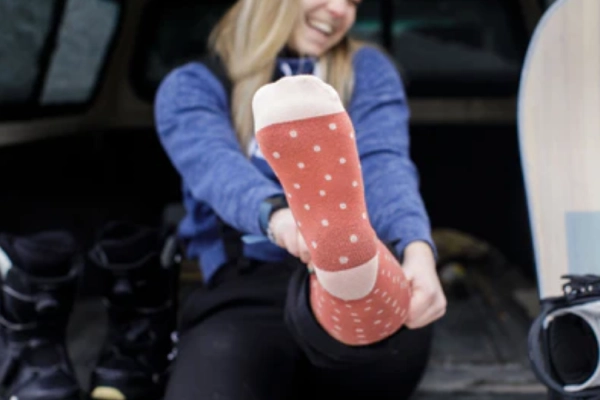
Knee-high compression socks play an essential role in supporting blood circulation, reducing swelling, and preventing fatigue in both medical and athletic contexts. From patients managing venous conditions to runners seeking faster recovery, these socks must stay securely in place to provide effective graduated compression.
However, one of the most common complaints is socks slipping down or rolling during wear. When compression socks slide out of position, they lose their therapeutic value and become a source of frustration. A reliable non-slip cuff design is, therefore, crucial. For years, most brands have used silicone grip bands to keep socks in place—but this solution comes with its own set of challenges.
This article explores traditional silicone-based non-slip designs, their limitations, and innovative alternatives such as anti-slip yarn technology. We’ll also examine real customer feedback, including the issue of cuff rolling (roll-edge), and share design improvements and care tips to help consumers get the best experience.
Traditional Silicone Grip – Pros & Cons
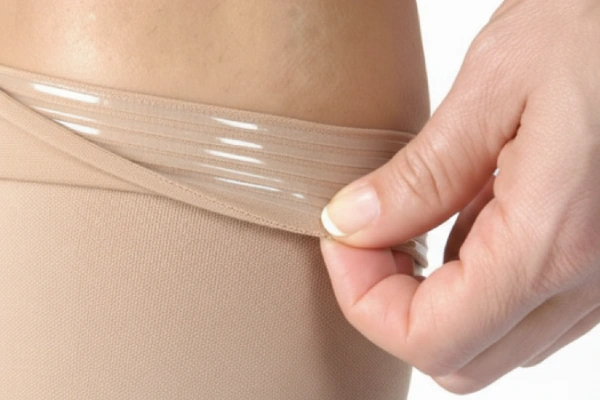
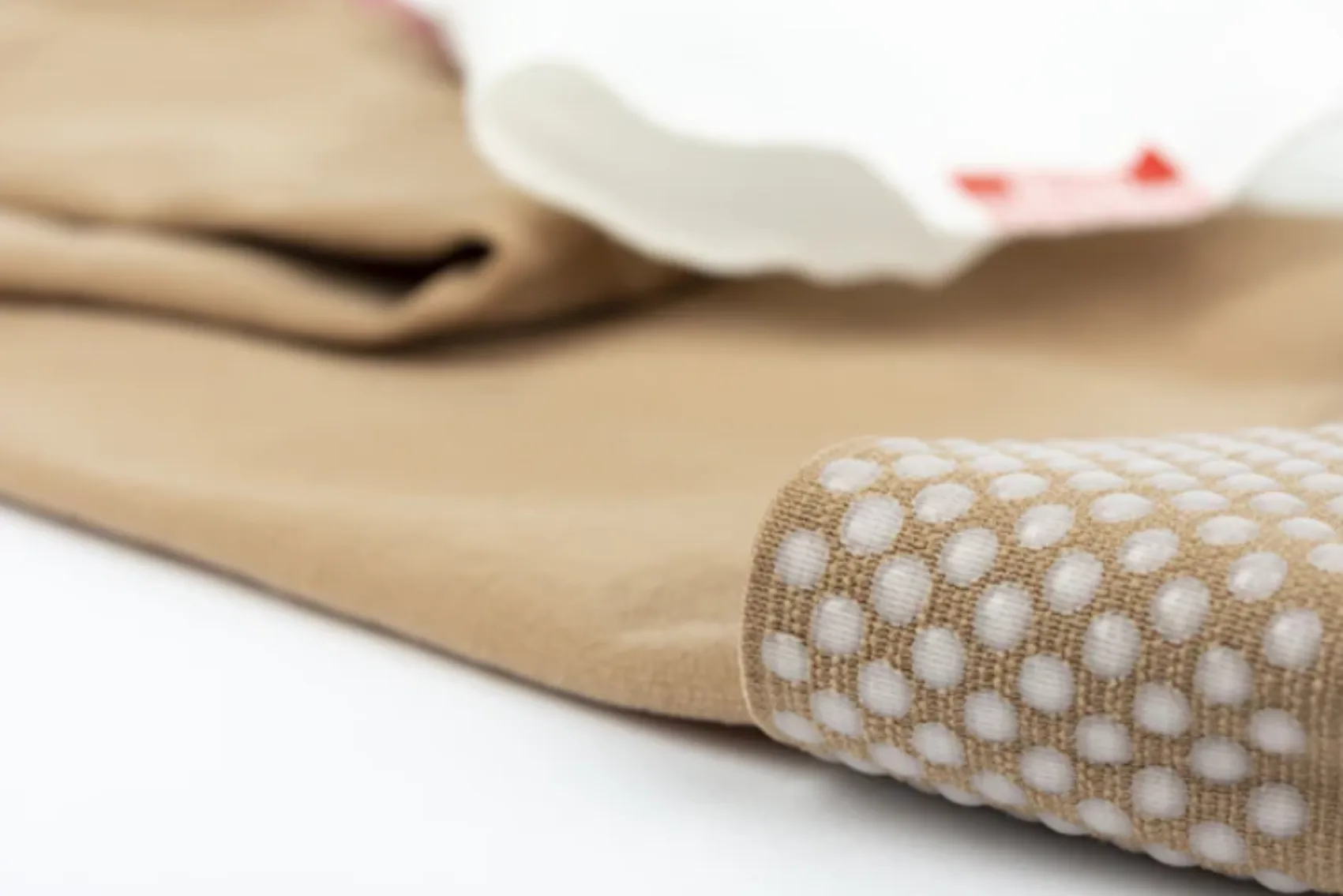
How Silicone Strips Work in Compression Socks
Most compression socks on the market use silicone strips or dots inside the cuff to create friction against the skin. Silicone’s inherent tackiness makes it effective for preventing downward sliding. The strips typically form a band around the sock opening or are arranged in patterns like dots or waves.
The idea is simple: when the cuff grips the skin, it resists gravity and motion, keeping the socks firmly in place. This method is widely used because it’s cost-effective and works well initially. Many medical-grade compression stockings also rely on silicone grippers for patients who wear them for long hours.
Common Problems with Silicone Bands
Despite their popularity, silicone grips come with significant drawbacks:
- Poor Breathability & Sweating: Silicone is not breathable. When pressed against the skin, it traps heat and moisture. Prolonged wear can cause sweating, leading to a sticky, clammy feeling around the cuff. This lack of ventilation is uncomfortable, particularly in warm climates or during physical activity.
- Skin Irritation & Allergies: Some users have sensitive skin or silicone allergies. Common complaints include redness, rashes, and itching around the cuff area. Even people without diagnosed allergies can develop irritation due to prolonged friction and trapped moisture.
- Hair Pulling & Discomfort: Silicone bands can tug on leg hair and leave visible marks or indentations after removal. This makes them unpleasant for some wearers.
- Maintenance Issues: To maintain their grip, silicone bands require frequent cleaning. Sweat and skin oils can accumulate, reducing their effectiveness. Over time, repeated washing may degrade the silicone’s tackiness, leading to reduced non-slip performance.
These problems have created a demand for alternative solutions that provide the same or better anti-slip function without compromising comfort or skin health.
Innovative Alternative – Anti-Slip Yarn Cuff Design
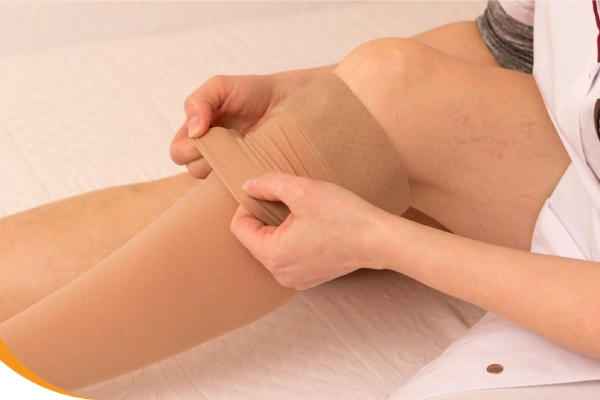
How Anti-Slip Yarn Works
Instead of adding a silicone layer on top of the cuff, some manufacturers now integrate anti-slip yarn directly into the fabric. This involves using high-friction fibers or yarns coated with micro-grip technology during the knitting process. The result is a cuff that grips naturally without relying on a sticky silicone surface.
For example, some patented solutions weave elastic fibers or specially treated threads into the cuff. The friction-enhanced yarn provides just enough grip to prevent sliding while maintaining the softness and flexibility of regular fabric. Because the grip is built into the fabric, there’s no separate band to peel off, crack, or lose function over time.
Advantages Over Silicone
Anti-slip yarn technology offers several benefits:
- Breathable and Comfortable: Unlike a solid silicone layer, the cuff remains fully breathable. Air circulates through the knitted structure, helping to wick moisture and keep skin dry. This makes it ideal for long-term wear and athletic performance.
- Allergy-Friendly: Since there’s no direct silicone contact, the risk of allergic reactions or skin irritation is greatly reduced. For sensitive skin users, this is a major improvement.
- Durable and Low-Maintenance: Because the anti-slip function is part of the fabric, it lasts as long as the sock does. Repeated washing doesn’t significantly affect performance. There’s no need for special cleaning routines to maintain grip.
- Natural Look and Feel: The cuff feels like soft fabric instead of a tacky silicone strip. This makes putting on and taking off socks more pleasant and improves the overall aesthetic.
Given these advantages, it’s easy to see why anti-slip yarn is gaining traction in the market. However, no design is perfect, and real-world feedback shows that even this innovation has areas for improvement.
Customer Feedback – The Cuff Rolling Issue
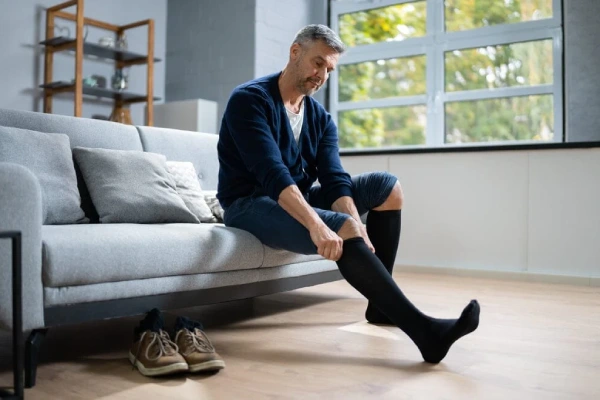
While anti-slip yarn solves many problems associated with silicone, some customers have reported another concern: cuff rolling, where the top of the sock rolls inward or outward during wear.
What Is the Cuff Rolling Problem?
Cuff rolling occurs when the top hem curls instead of lying flat against the leg. This can happen at the upper edge of the sock and may:
- Affect the appearance of the socks.
- Create uneven pressure, leaving marks or discomfort.
- Reduce the effectiveness of the anti-slip design if the cuff no longer makes full contact with the skin.
Why Does It Happen?
Several factors can contribute to cuff rolling:
- Uneven Tension in Knitting: If the cuff fabric’s tension is not evenly distributed, certain areas may have more “pull,” causing the edge to curl.
- Improper Sizing: A cuff that’s too tight may roll outward, while one that’s too loose may fold inward or slide.
- Leg Shape & Activity: Individuals with fuller calves or frequent knee bending may experience more cuff movement, leading to rolling.
- Wear & Care Issues: Repeated washing with high heat or rough handling can cause fabric fibers to lose elasticity and stability.
How to Stop Sock Cuffs from Rolling
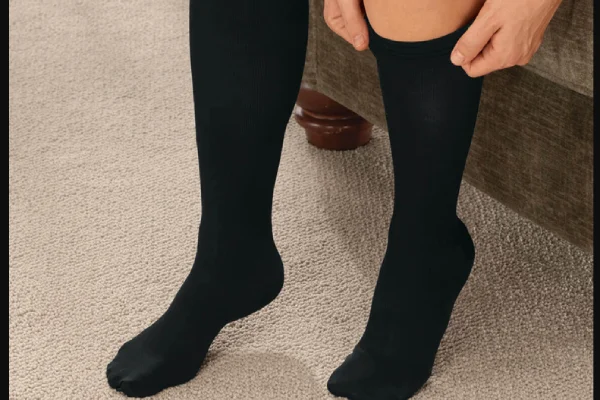
Design Improvements by Manufacturers
- Wider or Double-Layer Cuffs: A broader cuff distributes pressure more evenly and is less likely to curl. Double-layer knitting adds stability to the top hem.
- Reinforced Edge Fibers: Using slightly stiffer or elasticized yarn on the cuff’s top edge helps it maintain its shape.
- Optimized Tension Control: Advanced knitting machines can adjust tension precisely, ensuring uniform elasticity across the cuff.
Practical User Tips
- Choose the Correct Size: Proper sizing ensures the cuff sits snugly without excessive tightness or looseness.
- Follow Proper Care Instructions: Wash socks in cool water and air dry when possible to preserve elasticity.
- Replace Worn-Out Socks: Over time, all elastic fabrics degrade. If your socks are several years old and showing persistent rolling, it may be time for a new pair.
By combining design improvements with proper use, the roll-edge issue can be minimized, allowing users to fully benefit from anti-slip yarn technology.
Market Trends – Moving Beyond Silicone
Consumer demand is increasingly shifting toward comfort and skin-friendly materials. Brands that focus on silicone-free, breathable designs are gaining a competitive advantage. Innovations like anti-slip yarn demonstrate how textile engineering can solve long-standing user pain points.
Medical professionals also recommend hypoallergenic, breathable options for patients who must wear compression garments for extended periods. This further drives the market toward non-silicone solutions.
As technology advances, we can expect more performance-oriented features integrated into the fabric itself—like moisture-wicking, antibacterial treatments, and zoned compression—creating socks that are both functional and highly comfortable.
FAQs – Common Questions About Stay-Up Compression Socks
Why do my compression socks keep slipping down?
Compression socks often slip because of inadequate cuff grip, worn-out elastic, or mismatched sizing. Our innovative anti-slip yarn cuffs maintain consistent tension and grip without needing sticky silicone strips.
Can silicone bands cause skin allergies or rashes?
Yes, some users are allergic or sensitive to silicone, which can lead to redness, itching, or rashes. Our non-silicone anti-slip yarn design reduces these risks while maintaining grip.
Are anti-slip yarn compression socks better than silicone grip socks?
They offer better breathability, lower allergy risks, and a more natural feel. They are especially beneficial for sensitive skin users or those who wear socks for long periods.
How can I prevent the top of my socks from rolling down or curling (roll-edge)?
Choose the right size, wash gently to maintain elasticity, and opt for products with improved cuff design (like our reinforced anti-slip yarn cuffs).
How do I wash non-slip yarn compression socks?
Hand wash or use a delicate cycle with cold water; avoid high heat drying to preserve elasticity and prevent roll-edge or slipping issues.
Conclusion – The Future of Comfortable, Non-Slip Compression Socks
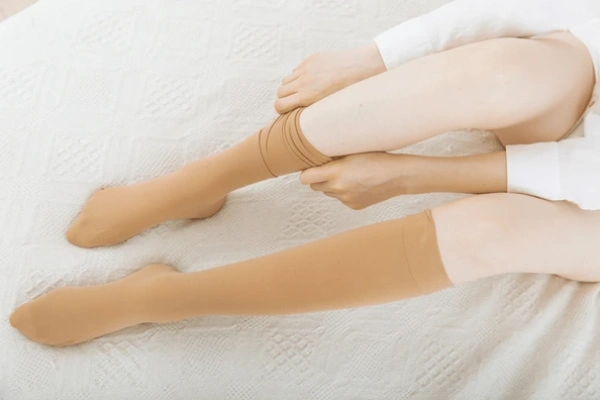
Non-slip cuff design is crucial for knee-high or thigh-high compression socks to deliver on their promise of improved circulation and comfort. While silicone bands have been the go-to solution for years, they come with challenges like sweating, skin irritation, and allergies.
Innovations such as anti-slip yarn technology offer a breathable, durable, and allergy-friendly alternative. And while roll-edge can occur, ongoing design improvements and proper care make this issue manageable.
As more consumers demand comfort without compromise, the future of compression socks lies in intelligent material engineering. By moving beyond silicone and focusing on user-centric design, brands can provide a superior wearing experience.
If you’re looking for compression socks that stay in place without the downsides of silicone, explore our silicone-free knee-high compression socks with advanced anti-slip yarn—designed for comfort, health, and performance.
